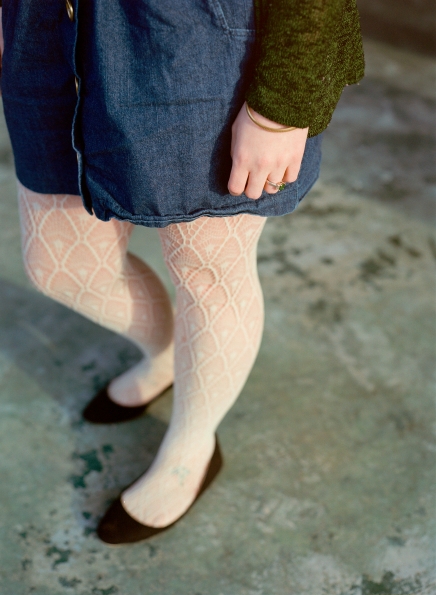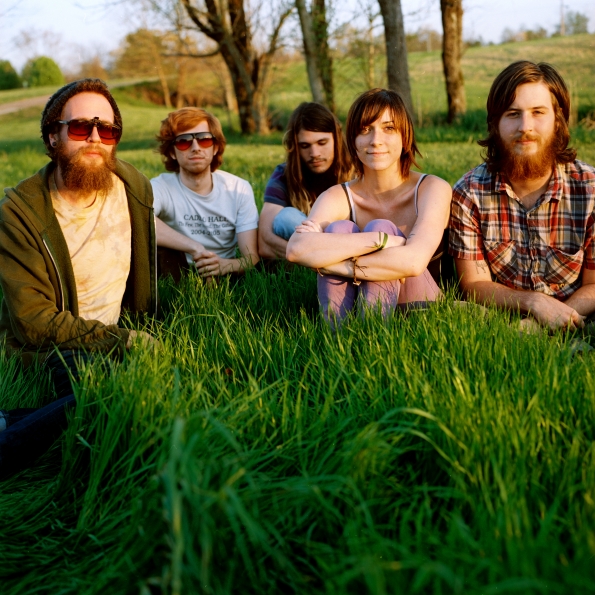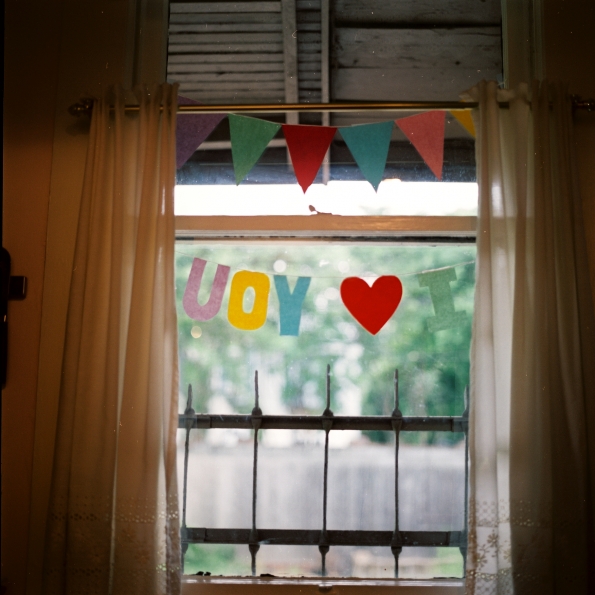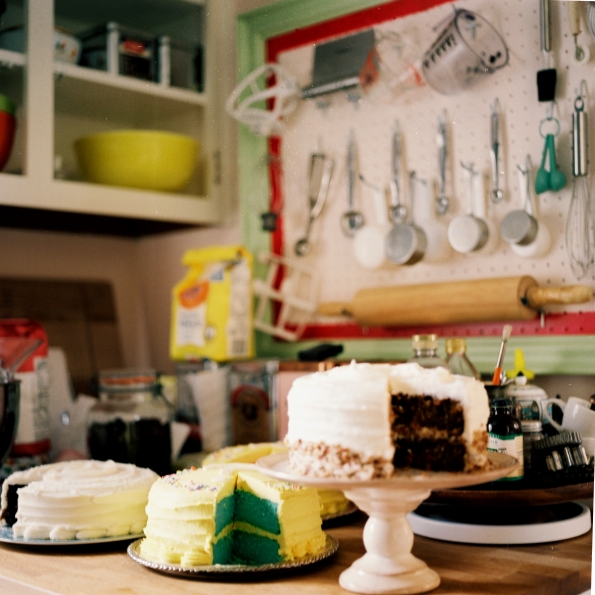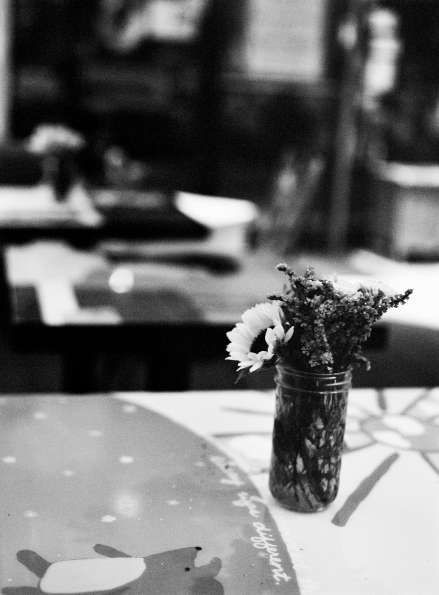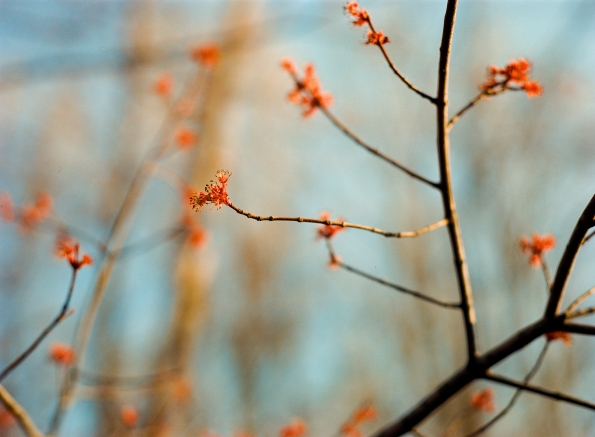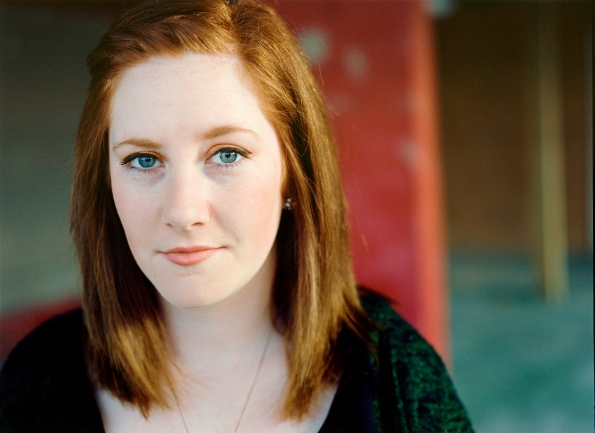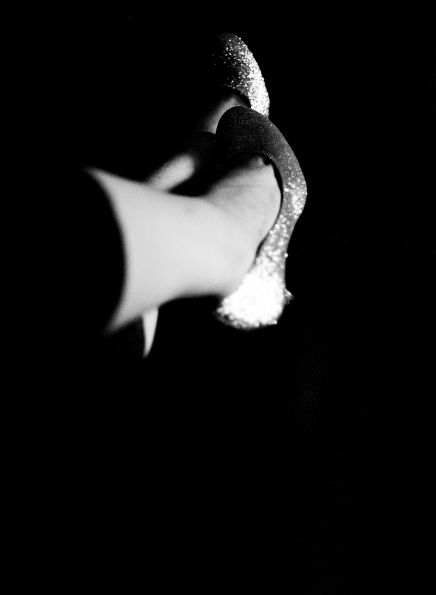I love instant photography. As it happens, this is ‘Roid Week 2009. I haven’t figured out yet which powers of be so dubbed it, but it doesn’t matter to me if it was just some person on the internet somewhere. I love instant photography (which I have already so plainly stated.) It’s hard to say it’s ‘Roid Week when, truthfully, there’s not really a Polaroid anymore. Thank GOD though, instant photography lives on. Fuji makes a film that fits a lot of Polaroid pack film cameras (as well as cameras manufactured by other companies, such as Keystone, which will be discussed later. ) It’s a thing of beauty! And there is a movement to begin production of film for Polaroid cameras called The Impossible Project. Pretty cool, huh?
So, here’s the rub: ‘Roid Week is juuuuuuust about over, and I have yet to have the opportunity to take any of my instant film cameras out for a spin. The good folks at Memphis Photo Supply happened to be out of the Fuji instant film I generally use, but may have some for me just in time for the very last day of ‘Roid week. They’re sweethearts, I tell ya. However, since ‘Roid Week is nearly up, and I haven’t been able to participate the way I would have liked, I decided to prepare for you folks The Epic Blog About Instant Photography. Wee! I know you’re excited.
I have been fortunate to have a number of Polaroid and other instant cameras at my disposal. If I weren’t such a poor photographer girl, I’d have been VERY fortunate and consequently have way more Polaroid pictures to show you. But I’ll give you a little taste of what I have to show from all the instant cameras I’ve had my paws on.
Instant cameras I have used throughout the years:
Cameras that use “integral” Polaroid film”
(the kind that you would be tempted to shake “like a Polaroid picture”, if Polaroid weren’t so concerned about the implications of such things. This film has all the processing chemicals contained within, unlike earlier Polaroid films.)
Polaroid One Step 600
I don’t know if this one really counts or not. My dad was working as a mechanic for a fleet of courier vans. He got this camera to take photos of the vans when they got into fender benders, for insurance purposes. I guess I didn’t get to use it much (please reference the aforementioned poorness of this photographer girl.) But I DO have this potentially embarrassing photo of my two younger brothers and a puppy that I took when we were teenagers. Are ya lovin it? Are my brothers going to hunt me down and make me pay for posting this on the internet? Possibly. Am I glad they don’t possess an equally embarrassing Polaroid of me circa 1996 to use for exacting their revenge? You bet!
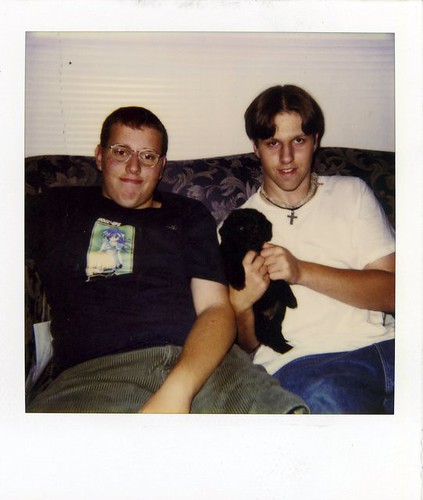
Polaroid Joycam
I wish I remembered more about how I came into possession of this camera. It must’ve been about 2003 or so, as that’s when most of the photos I have from that were taken. Including the PRECIOUS one of my niece you see below this paragraph. It took a type of integral film called Polaroid 500. This wasn’t the best camera or most full-featured in the world, but I mean, it’s called Joycam and just look at it. It’s cool. Film wasn’t widely availble for the Joycam by the time I’d owned it a couple of years. Back in 2005 or so, I found a stockpile of expired 500 film at a flea market for about a buck a pack. I was pumped. Then apparently my brother and his wife mistakenly threw out all the 500 film I’d stocked up, and I never got to use any of it ever again. Sad, but true, story.
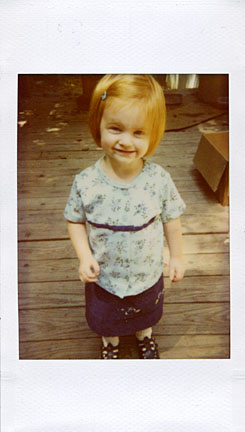
Polaroid I-zone
What fun little cameras the I-zones were! I had about 3 different styles of I-zone cameras. One of them changed colors when you touched it. One of them had interchangeable face plates (purple and blue.) And one of them was the Barbie edition I-zone (my friend Annie gave it to me.) I liked to use the I-zone for pictures of my friends. They were wild over the I-zone pictures. Especially the ones that were on “fortune film.” The way fortune film worked was: when the photo first came out of the camera, while the photo was developing, a little message was displayed where the picture eventually showed up. The message disappeared once the picture developed, so I used to write down the fortune before it was gone. They said things like “Dance. Always dance.” and “He’s not out of your league.” And basically, fortune film never lied. Whatever it said usually fit the subject of the photo.
Look how teeny the pictures were!

Polaroid SX-70 Sonar
I should do a whole blog just on this camera. Ahhhhhh! My favorite Polaroid integral film camera! I have had, oh, THREE of these, all of which have been the auto focus version of the camera. “How does this camera focus automatically?”, you may ask. BY USING SONAR. That’s right. JUST LIKE RUSSIAN SUBMARINES! Things that make this camera amazing: not only is it an auto focus camera, but it’s an SLR. That’s right. A POLAROID SLR. Not only is it an SLR, but it focuses WAY close. I think they say it focuses down to 10″ but I always feel like it goes closer than that (most Polaroid cameras don’t get closer than 3 feet, 2 feet at most.) AND DID I MENTION IT FOLDS [basically] FLAT WHEN YOU’RE NOT USING IT?! [see it in action]
The SX-70 was intended to take a film called Polaroid Time Zero. Some people dug this film because you could manipulate the picture if you messed with it during a certain timeframe after having taken the picture. I loved the photos it took just the way they were and didn’t do much manipulating (I’m not much of a manipulative person in general.) That film was still available widely back when I got one of these cameras. You could get it even at drug stores and the like. By 2006, Time Zero wasn’t around anymore. There were ways of using Polaroid’s (then) more readily avaible 600 film in the camera. It was no Time Zero film, I have to say, but I enjoyed a lot of shots I got with my SX-70 fitted with a neutral density filter and filled with 600 film. *sigh* If only I could get my hands on some 600 film now for the THIRD SX-70 I’ve just purchased (I couldn’t help it, ya’ll. I have such a soft spot in my heart for this camera. I just wanted another one, even if I never got any film for it and the most I could do with it was look at its pretty face.)
The first SX-70 I had, I found at a junk store/antique mall in 2003. I had seen SX-70s on the internet, but never in person. I saw it in the folded down posittion, and mistook it for a VHS tape momentarily. It was $10. The second one I bought was from that same antique store and was also $10, but I sent it to a friend in England shortly thereafter. The one I kept looked like this before it was all said and done:

But it still took pictures like this:
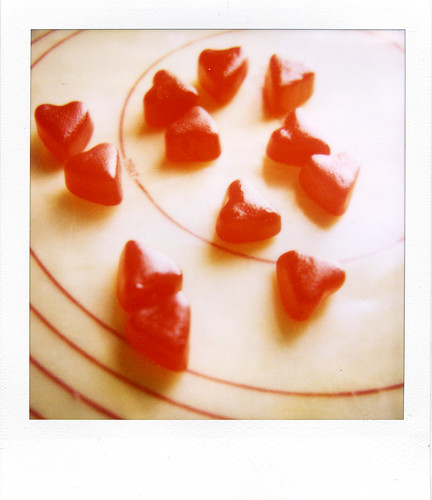
Ah-cha-cha. That camera had moxie, I tell ya! (imagine I’m Jimmy Durante for that last line.)
Also, please watch this highly informative and strangely beautiful commercial for the SX-70.
Polaroid Spectra 1200si
Oooooh. I liked this one. I think it was a 2005 ebay purchase. I was not getting to use my SX-70 anymore, and this was as close to that camera as I was going to get at the time. It, like the SX-70 was a Sonar auto focus camera (big plus!), though not an SLR like the SX-70. But it had a built-in flash, which was nice for snapshots or fill-flash. Unlike a lot of Polaroids though, you could turn the flash off and the camera would do long exposures (HUGE plus.) It took Polaroid Spectra film, which was pretty accessible at the time when I was using the camera. Funds for the film were not, however. I liked using the 1200si a lot, and would fire it up tomorrow if I had some film to put in it.
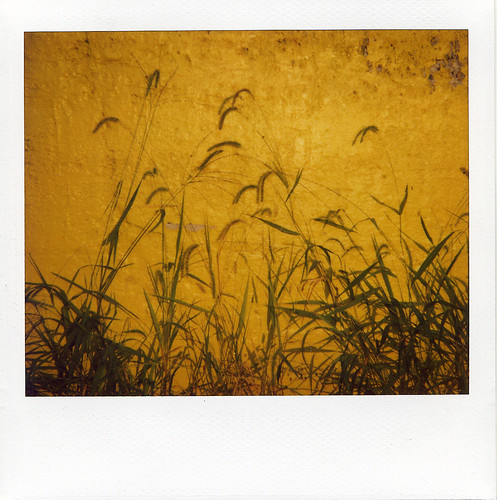
Polaroid Impulse AF
Ehm. I’m not sure why I bought this one. I bought it off ebay for around $5 in 2005, I suppose. It took the good ole Polaroid 600 film. The Impulse AF also had sonar auto focus, like the SX-70, but it seemed way less cool on this camera. I got some good shots with it, so I guess I got my $5 out of my Impulse AF. Maybe I’ll unearth Impulse one day if the Impossible Project works out.
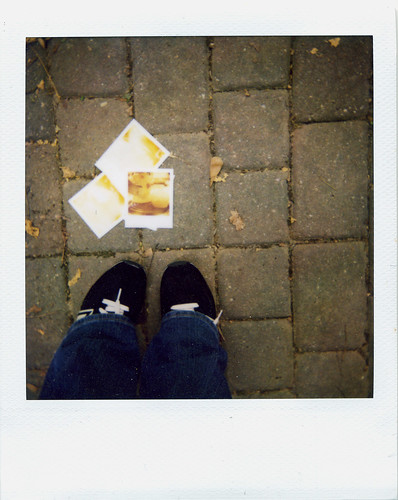
Polaroid cameras that use “non-integral” film
(aka peel-apart film. The chemicals which process the picture are exposed when you pull it open to reveal the developed picture. It’s kinda messy and requires you to time how long you let the photo develop, depending on what the air temperature is when you are letting the photo develop.)
Polaroid 250
I am in L-O-V-E with the pictures I get out of this camera. The quality is top-notch and SEE HOW AWESOME THE CAMERA LOOKS?! There are a number of cameras of the same ilk as the 250, but the features of the 250 include a rangefinder focusing system, long as h*ll exposures when needed, and a nice glass lens.
Know what’s cool about these kinds of cameras? The pull-apart film comes in color:
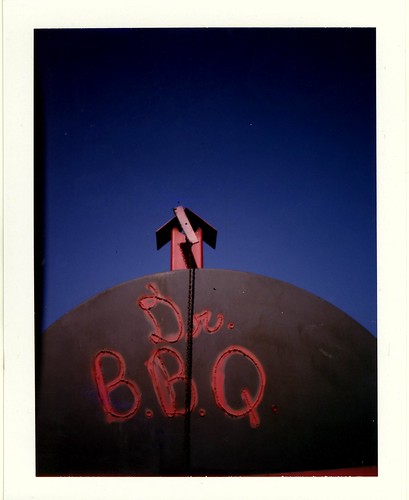
AND black and white:

The 250 is one of the cameras which accepts the type of film Fuji currently produces for instant photography. This is killer, considering these Polaroid cameras that use peel-apart film are just about the only Polaroid cameras which are very useful since Polaroid quit producing film themselves.
Polaroid Colorpack
I don’t own a Polaroid Colorpack. I was able to borrow one from my friend Drew earlier this year (and here is a picture of Drew actually holding the camera.) It’s another sweet peel-apart film camera. I think the pictures even look sorta like they were made in the 70s when I used the Colorpack. It’s got a plastic lens instead of glass, which probably adds to that vintage feel. Tres cool!

Non-Polaroid Instant Cameras:
Fuji Instax 200
This camera is pretty insane looking. I need to take a picture of it next to something normal sized so you can see how monstrous it is. I became sensitzed to the existence of the Instax camera because I saw a kid on the Canadian teen soap opera, Degrassi, using one. It was an instant camera, but wasn’t like any Polaroid I’d ever seen. My word! I got kinda obsessed with the idea of procuring an Instax, and even ended up getting a friend out of the deal. I posted photography forums that I needed someone in the UK to help me find one of these cameras and send it to me, and someone volunteered to help with this task. We found one for under £4. Got me some film, too. This is another camera I liked to use but never got to use enough. At the time, the only way to get film for it was to order from the UK (which I did, and it was cost-prohibitive to have it shipped over here.) Now, it seems like Instax film is available at most online camera supply stores. Maybe I will invest in some and take this baby for a spin. As far as limited-featured, point-and-shoot instant cameras go, I thought the quality was better than the Polaroid equivilant. The Instax’s appearance also had this cool factor that made my friends take notice when I whipped it out (although I couldn’t whip it out very quickly, since as I said, it’s monstrous.)

Keystone 800 Everflash
The Keystone is actually the most recent addition to my instant camera collection. I picked it up at the local camera shop. I saw it up on the shelf, asked one of the veteran photographers there was kind of camera it was, and ended up walking out having purchased the Keystone knowing only what the camera shop fellow told me about it. I can’t find much information about the Keystone online anywhere, nor can I find many photos on Flickr which were taken with the camera. However, I have quite enjoyed my Keystone. Like the Polaroid 250, I am able to use Fuji’s instant film in the Keystone. A cool feature on the Keystone, which other instant cameras produced at the time of the Keystone lacked, is the built-in flash. Most cameras back then used the dreaded flash cubes. Yuck! I don’t have much use for a flash on an instant camera, but it actually has come in handy so far. The camera does do long exposures when needed, something I always love in a camera that doesn’t let you set the exposure controls yourself. The Keystone has a plastic lens, but I’ve found it surprisingly sharp. Mmmm. I’m a fan of my Keystone, for sure.

Bonus: cheesy photo I took of my Keystone 800 at my portait studio job one day when I was bored.
(I know this blog was extremely long. I warned you in the beginning that it was gonna be epic though, so I applaud you if you stuck it out. Yay for instant photography! Check out more here in my galleries.)
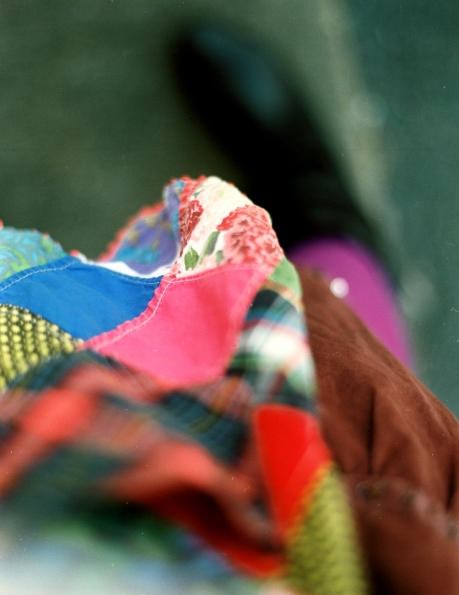
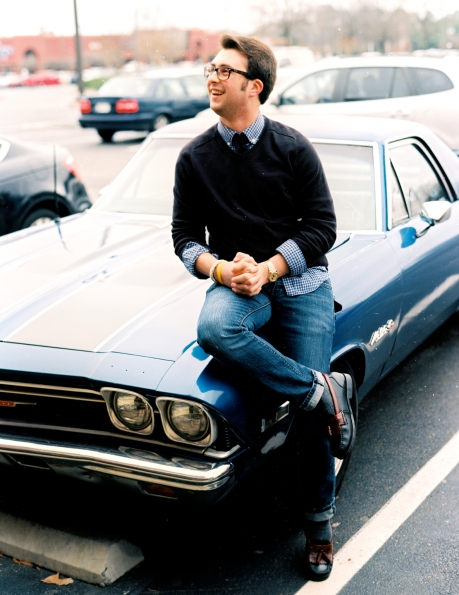
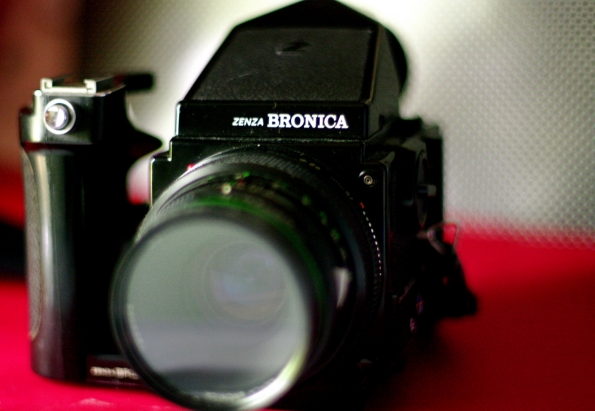 Meet my Bronica – we’re in a committed relationship
Meet my Bronica – we’re in a committed relationshipSpeed grip!!!


